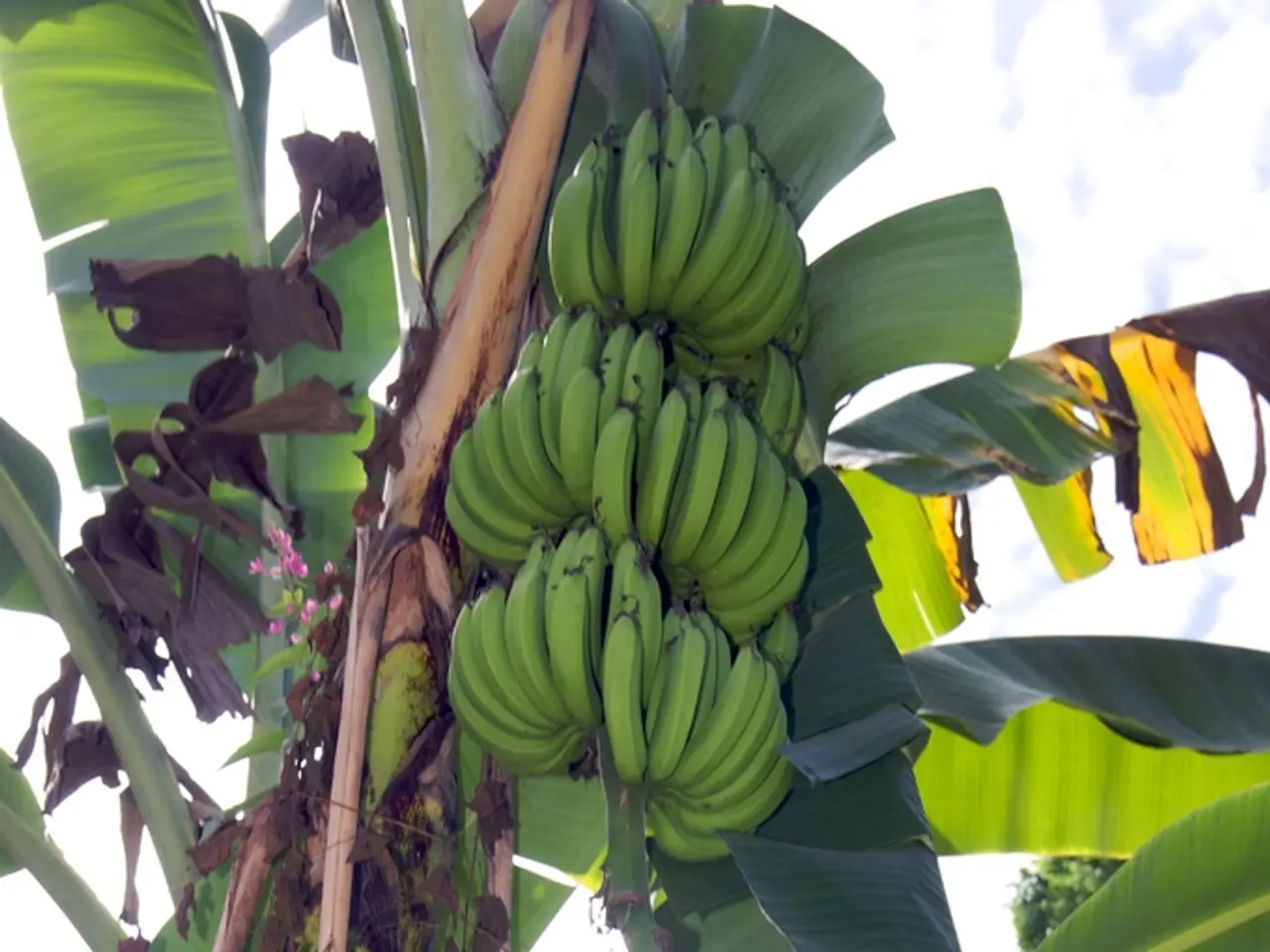Explore Surprising Applications of Banana Plants You May Not Be Aware Of
In the vibrant world of tropical cuisine, the humble banana plant takes centre stage, offering a multitude of uses that extend beyond its popular fruit. From serving plates to medicinal remedies, banana leaves, flowers, sap, and stems have become a staple in various cultures.
Banana leaves, considered sacred in many traditions, are often used as natural, waterproof wrappers to cook and steam food. This eco-friendly practice imparts a subtle aroma and sweetness to the dishes, making them a popular choice in Filipino and South Indian cuisines. Beyond their culinary role, banana leaves also serve as eye-catching serving plates or trays, adding a unique, green presentation to dishes. In some cultures, they are even crafted into decorative items like torans for home decor or ceremonial use.
The banana plant's flowers and sap are edible and have found their way into traditional cooking methods. Banana blossoms, often prepared as vegetable dishes or salads, are common in Southeast Asian cuisines. The stem, rich in fiber, is used in curries and stir-fries, while the sap can be extracted for medicinal or culinary purposes.
The leaves themselves, once used as serving plates, are discarded, but not without purpose. They are rich in polyphenols, natural antioxidants, which are thought to protect against lifestyle diseases. Eating food on banana leaves is also considered healthy and fortunate in India.
The banana stem, high in fiber, aids in the treatment of constipation and the maintenance of a healthy digestive tract. Consumption of banana flowers offers benefits such as lowering blood sugar levels and aiding in the prevention of anemia. Banana stem juice is beneficial for maintaining a healthy body, particularly in terms of preventing kidney stones and weight reduction.
Banana leaves have antibacterial qualities, making them potentially effective in destroying microorganisms in food. Their unique structure allows steam to easily penetrate food when used for steaming, enhancing the cooking process.
In the realm of health, the banana stem sap can be used to stop bleeding when applied directly to a wound. Banana plants should be planted in the spring, in a spot protected from severe winds, with composted soil and adequate space for growth.
While banana and plantain trees can be grown as houseplants, they usually don't bear fruit indoors. However, their edible parts continue to be a valuable resource, contributing to the rich tapestry of tropical cuisine and culture.
References:
- Banana Leaf Uses in Indian Cuisine
- Banana Leaves in Vietnamese Cuisine
- Banana Leaves in Filipino Cuisine
- Banana Leaves: More Than Just a Plate
- Decorative Uses of Banana Leaves
- In the realm of interior design, banana leaves are occasionally used as unique, eco-friendly decorative elements.
- The sap of the banana plant is rich in potassium, making it a useful component in some skin-care products and therapies-and-treatments.
- Unfortunately, the growing demand for fashion-and-beauty products has led to the overharvesting of banana plants, threatening sustainable-living practices.
- In the pursuit of workplace-wellness, nutritionists often advocate for the inclusion of more fruits like bananas and vegetables into our daily meals, promoting healthy-cooking methods.
- As a versatile ingredient in global-cuisines, banana blossoms can be prepared in various ways, ranging from stir-fries to curries, recipes that can be found in cookbooks dedicated to sustainable-living.
- In various cultures, banana trees are symbolically associated with growth and nourishment, and are often planted in gardens to promote outdoor-living and home-and-garden aesthetics.
- The popularity of CBD, a non-psychoactive compound found in cannabis plants, has led to the exploration of its potential benefits in food-and-drink and health-and-wellness industries.
- Some researchers are investigating the possibility of using banana plant fibers in the production of sustainable, eco-friendly furniture, contributing to the field of home-improvement.
- Despite many benefits, too much consumption of banana sap can lead to skin irritation for some individuals, emphasizing the need for moderation in all aspects of nutrition and skin-care.
- In the realms of science and gardening, banana plants have proven to be a fascinating subject, offering insights into the biology of plants and potential applications in sustainable-living.
- Popular worldwide, the humble banana is not just a delicious fruit, it is a symbol of various facets of life, from food-and-drink and cooking to fashion-and-beauty, health-and-wellness, and gardening.
- The fibrous nature of the banana stem can also be used to create natural cleaning sponges, adding to its list of useful applications in our daily lives.
- From the dinner table to the medicinal remedy, skin-care product, decorative item, furniture, and cleaning sponge, the banana plant continues to surprise us with its versatility and potential.




